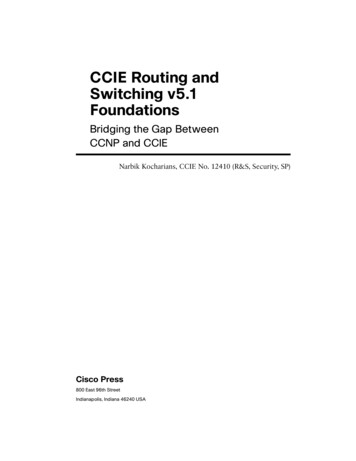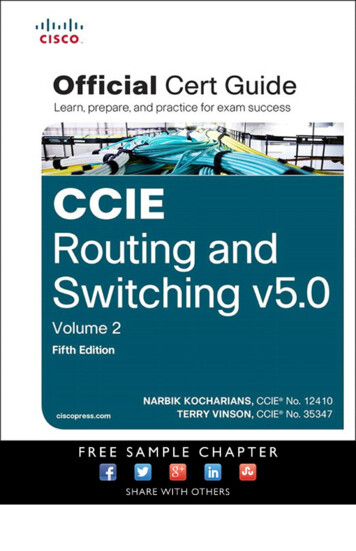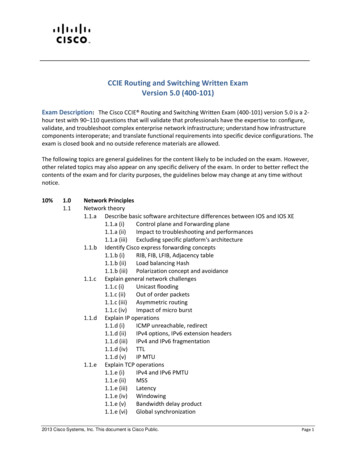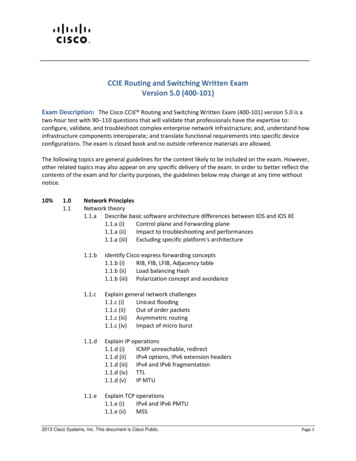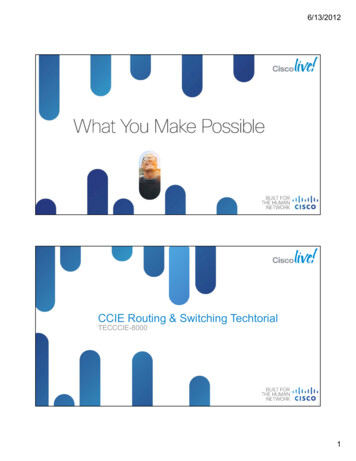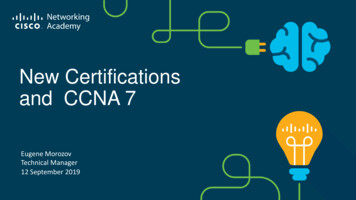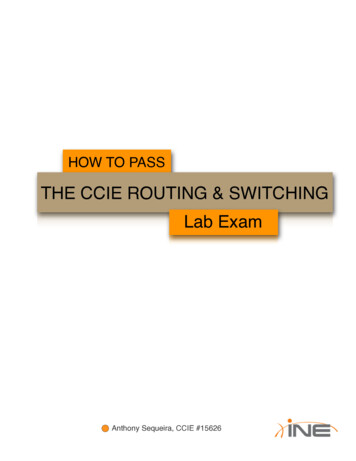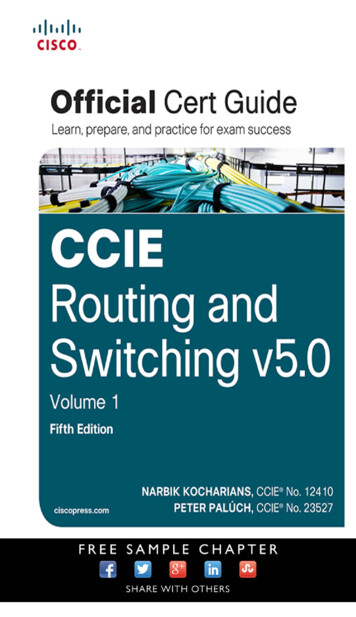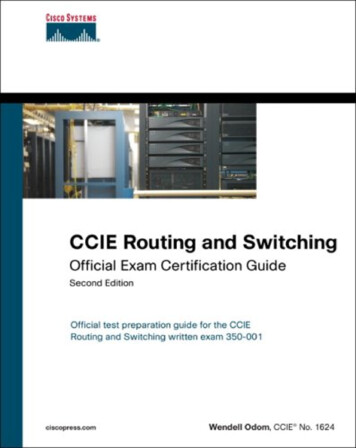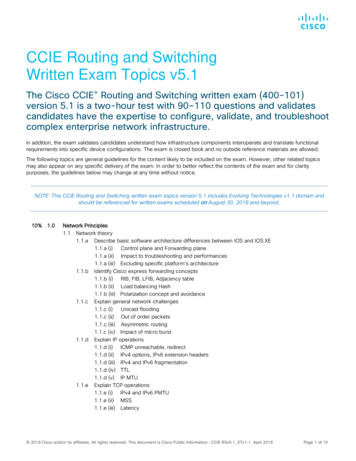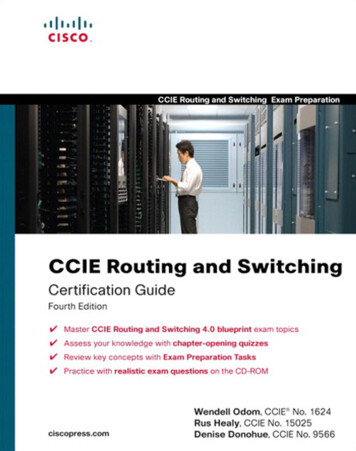
Transcription
iiCCIE Routing and Switching Certification Guide, Fourth EditionWendell Odom, CCIE No. 1624Rus Healy, CCIE No. 15025Denise Donohue, CCIE No. 9566Copyright 2010 Pearson Education, Inc.Published by:Cisco Press800 East 96th StreetIndianapolis, IN 46240 USAAll rights reserved. No part of this book may be reproduced or transmitted in any form or by any means, electronic ormechanical, including photocopying, recording, or by any information storage and retrieval system, without writtenpermission from the publisher, except for the inclusion of brief quotations in a review.Printed in the United States of AmericaFirst Printing November 2009Library of Congress Cataloging-in-Publication DataOdom, Wendell.CCIE routing and switching exam certification guide / Wendell Odom, Rus Healy, Denise Donohue. -- 4th ed.p. cm.Includes index.ISBN-13: 978-1-58705-980-3 (hardcover w/cd)ISBN-10: 1-58705-980-0 (hardcover w/cd) 1. Telecommunications engineers—Certification—Study guides.2. Routing (Computer network management)—Examinations—Study guides. 3. s—Study guides. 4. Computer networks—Examinations—Study guides. 5. ��Study guides. I. Healy, Rus. II. Donohue, Denise. III. Title.QA76.3.B78475 2010004.6—dc222009041604ISBN-13: 978-1-58705-980-3ISBN-10: 1-58705-980-0Warning and DisclaimerThis book is designed to provide information about Cisco CCIE Routing and Switching Written Exam, No. 350-001.Every effort has been made to make this book as complete and as accurate as possible, but no warranty or fitness isimplied.The information is provided on an “as is” basis. The authors, Cisco Press, and Cisco Systems, Inc. shall have neitherliability nor responsibility to any person or entity with respect to any loss or damages arising from the informationcontained in this book or from the use of the discs or programs that may accompany it.The opinions expressed in this book belong to the author and are not necessarily those of Cisco Systems, Inc.Trademark AcknowledgmentsAll terms mentioned in this book that are known to be trademarks or service marks have been appropriately capitalized. Cisco Press or Cisco Systems, Inc., cannot attest to the accuracy of this information. Use of a term in this bookshould not be regarded as affecting the validity of any trademark or service mark.
iiiCorporate and Government SalesCisco Press offers excellent discounts on this book when ordered in quantity for bulkpurchases or special sales. For more information, please contact: U.S. Corporate and Government Sales1-800-382-3419 corpsales@pearsontechgroup.comFor sales outside of the U.S. please contact: International Sales1-317-581-3793 international@pearsontechgroup.comFeedback InformationAt Cisco Press, our goal is to create in-depth technical books of the highest quality and value. Each book is craftedwith care and precision, undergoing rigorous development that involves the unique expertise of members from the professional technical community.Readers’ feedback is a natural continuation of this process. If you have any comments regarding how we couldimprove the quality of this book, or otherwise alter it to better suit your needs, you can contact us through email atfeedback@ciscopress.com. Please make sure to include the book title and ISBN in your message.We greatly appreciate your assistance.Publisher: Paul BogerAssociate Publisher: Dave DusthimerCisco Representative: Erik UllandersonCisco Press Program Manager: Anand SundaramExecutive Editor: Brett BartowManaging Editor: Patrick KanouseDevelopment Editor: Dayna IsleyProject Editor: Seth KerneyCopy Editor: Keith ClineTechnical Editor(s): Maurilio Gorito, Narbik KochariansEditorial Assistant: Vanessa EvansBook Designer: Louisa AdairComposition: Mark ShirarIndexer: Tim WrightProofreader: Apostrophe Editing Services
xxxiForewordCCIE Routing and Switching Exam Certification Guide, Fourth Edition, is an excellentself-study resource for the CCIE Routing and Switching written exam. Passing this examis the first step to attaining the valued CCIE Routing and Switching certification andqualifies candidates for the CCIE Routing and Switching lab exam.Gaining certification in Cisco technology is key to the continuing educational developmentof today’s networking professional. Through certification programs, Cisco validates theskills and expertise required to effectively manage the modern enterprise network.Cisco Press Exam Certification Guides and preparation materials offer exceptional—andflexible—access to the knowledge and information required to stay current in your field ofexpertise or to gain new skills. Whether used as a supplement to more traditional trainingor as a primary source of learning, these materials offer users the information andknowledge validation required to gain new understanding and proficiencies.Developed in conjunction with the Cisco certifications and training team, Cisco Pressbooks are the only self-study books authorized by Cisco and offer students a series of exampractice tools and resource materials to help ensure that learners fully grasp the conceptsand information presented.Additional authorized Cisco instructor-led courses, e-learning, labs, and simulations areavailable exclusively from Cisco Learning Solutions Partners worldwide. To learn more,visit http://www.cisco.com/go/training.I hope that you find these materials to be an enriching and useful part of your exampreparation.Erik UllandersonManager, Global CertificationsLearning@CiscoOctober 2007
xxxiiIntroductionThe Cisco Certified Internetwork Expert (CCIE) certification may be the most challengingand prestigious of all networking certifications. It has received numerous awards andcertainly has built a reputation as one of the most difficult certifications to earn in all of thetechnology world. Having a CCIE certification opens doors professionally typically resultsin higher pay and looks great on a resume.Cisco currently offers several CCIE certifications. This book covers the version 4.0 examblueprint topics of the written exam for the CCIE Routing and Switching certification. Thefollowing list details the currently available CCIE certifications at the time of this book’spublication; check http://www.cisco.com/go/ccie for the latest information. Thecertifications are listed in the order in which they were made available to the public: CCIE Routing and Switching CCIE Security CCIE Service Provider CCIE Voice CCIE Storage Networking CCIE WirelessEach of the CCIE certifications requires the candidate to pass both a written exam and aone-day, hands-on lab exam. The written exam is intended to test your knowledge of theory,protocols, and configuration concepts that follow good design practices. The lab examproves that you can configure and troubleshoot actual gear.
xxxiiiWhy Should I Take the CCIE Routing and SwitchingWritten Exam?The first and most obvious reason to take the CCIE Routing and Switching written exam isthat it is the first step toward obtaining the CCIE Routing and Switching certification. Also,you cannot schedule a CCIE lab exam until you pass the corresponding written exam. Inshort, if you want all the professional benefits of a CCIE Routing and Switchingcertification, you start by passing the written exam.The benefits of getting a CCIE certification are varied, among which are the following: Better pay Career-advancement opportunities Applies to certain minimum requirements for Cisco Silver and Gold Channel Partners,as well as those seeking Master Specialization, making you more valuable to ChannelPartners Better movement through the problem-resolution process when calling the Cisco TAC Prestige Credibility for consultants and customer engineers, including the use of the CiscoCCIE logoThe other big reason to take the CCIE Routing and Switching written exam is that itrecertifies an individual’s associate-, professional-, and expert-level Cisco certifications. Inother words, passing any CCIE written exam recertifies that person’s CCNA, CCNP, CCIP,CCSP, CCDP, and so on. (Recertification requirements do change, so please verify therequirements at http://www.cisco.com/go/certifications.)
xxxivCCIE Routing and Switching Written Exam 350-001The CCIE Routing and Switching written exam, at the time of this writing, consists of atwo-hour exam administered at a proctored exam facility affiliated with Pearson VUE(http://www.vue.com/cisco). The exam typically includes approximately 100 multiplechoice questions. No simulation questions are currently part of the written exam.As with most exams, everyone wants to know what is on the exam. Cisco provides generalguidance as to topics on the exam in the CCIE Routing and Switching written examblueprint, the most recent copy of which can be accessed from http://www.cisco.com/go/ccie.Cisco changes both the CCIE written and lab blueprints over time, but Cisco seldom, ifever, changes the exam numbers. (In contrast, Cisco changes the exam numbers of theassociate- and professional-level certifications when it makes major changes to what iscovered on those exams.) Instead of changing the exam number when a CCIE examchanges significantly, Cisco publishes a new exam blueprint. Cisco assigns the newblueprint a version number, much like a software version.The CCIE Routing and Switching written exam blueprint 4.0, as of the time of publication,is listed in Table I-1. Table I-1 also lists the chapters that cover each topic.Table I-1CCIE Routing and Switching Written Exam BlueprintTopicsBookChapters1.00 Implement Layer 2 Technologies1.10 Implement Spanning Tree Protocol (STP)3(a) 802.1d3(b) 802.1w3(c) 801.1s3(d) Loop guard3(e) Root guard3(f) Bridge protocol data unit (BPDU) guard3(g) Storm control3(h) Unicast flooding3(i) Port roles, failure propagation, and Loop Guard operation31.20 Implement VLAN and VLAN Trunking Protocol (VTP)21.30 Implement trunk and trunk protocols, EtherChannel, and load-balance2
xxxvTable I-1CCIE Routing and Switching Written Exam Blueprint (Continued)TopicsBookChapters1.40 Implement Ethernet technologies1(a) Speed and duplex1(b) Ethernet, Fast Ethernet, and Gigabit Ethernet1(c) PPP over Ethernet (PPPoE)21.50 Implement Switched Port Analyzer (SPAN), Remote Switched Port Analyzer(RSPAN), and flow control11.60 Implement Frame Relay15(a) Local Management Interface (LMI)15(b) Traffic shaping15(c) Full mesh15(d) Hub and spoke15(e) Discard eligible (DE)151.70 Implement High-Level Data Link Control (HDLC) and PPP152.00 Implement IPv42.10 Implement IP version 4 (IPv4) addressing, subnetting, and variable-length subnetmasking (VLSM)42.20 Implement IPv4 tunneling and Generic Routing Encapsulation (GRE)62.30 Implement IPv4 RIP version 2 (RIPv2)E2.40 Implement IPv4 Open Shortest Path First (OSPF)8(a) Standard OSPF areas8(b) Stub area8(c) Totally stubby area8(d) Not-so-stubby-area (NSSA)8(e) Totally NSSA8(f) Link-state advertisement (LSA) types8(g) Adjacency on a point-to-point and on a multi-access network8(h) OSPF graceful restart82.50 Implement IPv4 Enhanced Interior Gateway Routing Protocol (EIGRP)7(a) Best path7(b) Loop-free paths7(c) EIGRP operations when alternate loop-free paths are available, and when they arenot available7continues
xxxviTable I-1CCIE Routing and Switching Written Exam Blueprint (Continued)TopicsBookChapters(d) EIGRP queries7(e) Manual summarization and autosummarization9(f) EIGRP stubs72.60 Implement IPv4 Border Gateway Protocol (BGP)10(a) Next hop10(b) Peering10(c) Internal Border Gateway Protocol (IBGP) and External Border Gateway Protocol(EBGP)10, 112.70 Implement policy routing62.80 Implement Performance Routing (PfR) and Cisco Optimized Edge Routing (OER)62.90 Implement filtering, route redistribution, summarization, synchronization, attributes,and other advanced9, 113.00 Implement IPv63.10 Implement IP version 6 (IPv6) addressing and different addressing types203.20 Implement IPv6 neighbor discovery203.30 Implement basic IPv6 functionality protocols203.40 Implement tunneling techniques203.50 Implement OSPF version 3 (OSPFv3)203.60 Implement EIGRP version 6 (EIGRPv6)203.70 Implement filtering and route redistribution204.00 Implement MPLS Layer 3 VPNs194.10 Implement Multiprotocol Label Switching (MPLS)194.20 Implement Layer 3 virtual private networks (VPNs) on provider edge (PE), provider(P), and customer edge (CE) routers194.30 Implement virtual routing and forwarding (VRF) and Multi-VRF Customer Edge(VRF-Lite)195.00 Implement IP Multicast5.10 Implement Protocol Independent Multicast (PIM) sparse mode16, 175.20 Implement Multicast Source Discovery Protocol (MSDP)175.30 Implement interdomain multicast routing175.40 Implement PIM Auto-Rendezvous Point (Auto-RP), unicast rendezvous point (RP),and bootstrap router (BSR)17
xxxviiTable I-1CCIE Routing and Switching Written Exam Blueprint (Continued)TopicsBookChapters5.50 Implement multicast tools, features, and source-specific multicast175.60 Implement IPv6 multicast, PIM, and related multicast protocols, such as MulticastListener Discovery (MLD)176.00 Implement Network Security6.01 Implement access lists186.02 Implement Zone Based Firewall186.03 Implement Unicast Reverse Path Forwarding (uRPF)186.04 Implement IP Source Guard186.05 Implement authentication, authorization, and accounting (AAA) (configuring theAAA server is not required, only the client side (IOS) is configured)186.06 Implement Control Plane Policing (CoPP)186.07 Implement Cisco IOS Firewall186.08 Implement Cisco IOS Intrusion Prevention System (IPS)186.09 Implement Secure Shell (SSH)186.10 Implement 802.1x186.11 Implement NAT186.12 Implement routing protocol authentication186.13 Implement device access control186.14 Implement security features187.00 Implement Network Services7.10 Implement Hot Standby Router Protocol (HSRP)57.20 Implement Gateway Load Balancing Protocol (GLBP)57.30 Implement Virtual Router Redundancy Protocol (VRRP)57.40 Implement Network Time Protocol (NTP)57.50 Implement DHCP57.60 Implement Web Cache Communication Protocol (WCCP)58.00 Implement Quality of Service (QoS)8.10 Implement Modular QoS CLI (MQC)12(a) Network-Based Application Recognition (NBAR)12(b) Class-based weighted fair queuing (CBWFQ), modified deficit round robin (MDRR),and low latency queuing (LLQ)13(c) Classification12continues
xxxviiiTable I-1CCIE Routing and Switching Written Exam Blueprint (Continued)TopicsBookChapters(d) Policing14(e) Shaping14(f) Marking12(g) Weighted random early detection (WRED) and random early detection (RED)13(h) Compression158.20 Implement Layer 2 QoS: weighted round robin (WRR), shaped round robin (SRR),and policies138.30 Implement link fragmentation and interleaving (LFI) for Frame Relay158.40 Implement generic traffic shaping148.50 Implement Resource Reservation Protocol (RSVP)138.60 Implement Cisco AutoQoS129.00 Troubleshoot a Network9.10 Troubleshoot complex Layer 2 network issues39.20 Troubleshoot complex Layer 3 network issues99.30 Troubleshoot a network in response to application problems149.40 Troubleshoot network services69.50 Troubleshoot network security1810.00 Optimize the Network10.01 Implement syslog and local logging510.02 Implement IP Service Level Agreement SLA510.03 Implement NetFlow510.04 Implement SPAN, RSPAN, and router IP traffic export (RITE)510.05 Implement Simple Network Management Protocol (SNMP)510.06 Implement Cisco IOS Embedded Event Manager (EEM)510.07 Implement Remote Monitoring (RMON)510.08 Implement FTP510.09 Implement TFTP510.10 Implement TFTP server on router510.11 Implement Secure Copy Protocol (SCP)510.12 Implement HTTP and HTTPS510.13 Implement Telnet5
xxxixTable I-1CCIE Routing and Switching Written Exam Blueprint (Continued)BookChaptersTopics11.00 Evaluate proposed changes to a Network11.01 Evaluate interoperability of proposed technologies against deployed technologiesN/A(a) Changes to routing protocol parametersN/A(b) Migrate parts of a network to IPv6N/A(c) Routing Protocol migrationN/A(d) Adding multicast supportN/A(e) Migrate spanning tree protocolN/A(f) Evaluate impact of new traffic on existing QoS designN/A11.02 Determine operational impact of proposed changes to an existing networkN/A(a) Downtime of network or portions of networkN/A(b) Performance degradationN/A(c) Introducing security breachesN/A11.03 Suggest Alternative solutions when incompatible changes are proposed to anexisting networkN/A(a) Hardware/Software upgradesN/A(b) Topology shiftsN/A(c) ReconfigurationsN/AVersion 4.0 of the blueprint provides more detail than the earlier versions of the blueprint.It is also helpful to know what topics Cisco has removed from earlier blueprints, because itis also useful to know what not to study as well as what to study. The more significant topicsremoved from the last few versions of the CCIE R/S Written blueprints include thefollowing: Version 2.0 (2005)—Cisco announced the removal of ISDN/DDR, IS-IS, ATM, andSONET; they also added wireless LANs Version 3.0 (2007)—The Version 3.0 blueprint showed the removal of wireless LANs,and added IPv6 and MPLS concepts. Version 4.0 (2009)—The Version 4.0 blueprint shows that no significant topics wereremoved.The Version 4.0 blueprint adds many new topics compared to the Version 3.0 blueprint. Theblueprint mentions around 20 new small topics. In addition, the blueprint wording has beenchanged to be more aligned with the other Cisco certifications, with many of the topicslisting the word configuration. Notably, MPLS configuration has been added since
xlVersion 3.0, with several of the small topics, ranging in one to three pages of coverage inthe book, also now including some configuration discussion.The Version 4.0 blueprint also now includes five troubleshooting topics, as listed insection 9.0 of the blueprint, and paraphrased as follows: LANs IP routing Application performance (QoS) Network services SecurityThe existence of specific topics for troubleshooting may be a bit confusing at first, becausethe CCIE lab also now contains a specific troubleshooting component. However, the priorversions of the CCIE written exam already included questions asked in the context of abroken network or misconfigured device. These new blueprint items simply formalize theidea that you should not only understand proper configuration, but be able to predict whatwill happen when problems occur.Finally, the other big change between the Version 3.0 and Version 4.0 blueprint relates tosection 11.0 of the blueprint. This new section might be better termed “Dealing with issuesthat arise in real life when networks change.” Section 11.0, actually titled “EvaluateProposed Changes to a Network,” diverges from the usual convention of a list of specifictechnologies. Instead, section 11.0 lists topics about how engineers do their jobs.Specifically, these topics relate to issues that arise when implementing networktechnologies in an existing network—topics that can be well learned by doing a networkengineering job, and questions that can be answered by applying the vast amount ofinformation covered through the whole book. From one perspective, the whole bookalready covers the topics in this section, but there is no specific section of the printed bookthat addresses these topics.To give you practice on these topics, and pull the topics together, Edition 4 of the CCIERouting and Switching Exam Certification Guide includes a large set of CD questions thatmirror the types of questions expected for part 11 of the Version 4.0 blueprint. By their verynature, these topics require the application of the knowledge listed throughout the book.This special section of questions provides a means to learn and practice these skills with aproportionally larger set of questions added specifically for this purpose.These questions will be available to you in the practice test engine database, whether youtake full exams or choose questions by category.
xliAbout the CCIE Routing and Switching Official ExamCertification Guide, Fourth EditionThis section provides a brief insight into the contents of the book, the major goals, and someof the book features that you will encounter when using this book.Book OrganizationThis book contains nine major parts. The book places the longer and the more long-livedtopics earlier in the book. For example, the most familiar topics, LAN switching and IPv4routing, occupy the first three parts, and consume more than 400 pages of the book. QoS,which has been a part of the blueprint for a long times, follows as part IV.Beyond the chapters in the nine major parts of the book, you will find several usefulappendixes gathered in Part X.Following is a description of each part’s coverage: Part I, “LAN Switching” (Chapters 1–3)This part focuses on LAN Layer 2 features, specifically Ethernet (Chapter 1), VLANsand trunking (Chapter 2), and Spanning Tree Protocol (Chapter 3). Part II, “IP” (Chapters 4–5)This part is titled “IP” to match the blueprint, but it might be better titled “TCP/IP”because it covers details across the spectrum of the TCP/IP protocol stack. It includesIP addressing (Chapter 4) and IP services such as DHCP and ARP (Chapter 5). Part III, “IP Routing” (Chapters 6–11)This part covers some of the more important topics on the exam and is easily the largestpart of the book. It covers Layer 3 forwarding concepts (Chapter 6), followed by tworouting protocol chapters, one each about EIGRP and OSPF (Chapters 7 and 8,respectively). (Note that while RIP Version 2 is listed in the blueprint, its role iswaning; therefore, that material exists in this book as CD-only Appendix E.) Followingthat, Chapter 9 covers route redistribution between IGPs. At the end, Chapter 10 hitsthe details of BGP, with Chapter 11 looking at BGP path attributes and how toinfluence BGP’s choice of best path. Part IV, “QoS” (Chapters 12–14)This part covers the more popular QoS tools, including some MQC-based tools, aswell as several older tools, particularly FRTS. The chapters include coverage ofclassification and marking (Chapter 12), queuing and congestion avoidance(Chapter 13), plus shaping, policing, and link efficiency (Chapter 14).
xlii Part V, “Wide-Area Networks” (Chapter 15)The WAN coverage has been shrinking over the last few revisions to the CCIE R&Swritten exam. Chapter 15 includes some brief coverage of PPP and Frame Relay. Notethat the previous version (V3.0) and current version (V4.0) of the blueprint includesanother WAN topic, MPLS, which is covered in Part VIII, Chapter 19. Part VI, “IP Multicast” (Chapters 16–17)Chapter 16 covers multicast on LANs, including IGMP and how hosts join multicastgroups. Chapter 17 covers multicast WAN topics. Part VII, “Security” (Chapter 18)Given the CCIE tracks for both Security and Voice, Cisco has a small dilemmaregarding whether to cover those topics on CCIE Routing and Switching, and if so,in how much detail. This part covers a variety of security topics appropriate for CCIERouting and Switching, in a single chapter. This chapter focuses on switch and routersecurity. Part VIII, “MPLS” (Chapter 19)As mentioned in the WAN section, the CCIE R&S exam’s coverage of MPLS has beengrowing over the last two versions of the blueprint. This chapter focuses on enterpriserelated topics such as core MPLS concepts and MPLS VPNs, including basicconfiguration. Part IX, “IP Version 6” (Chapter 20)Chapter 20 examines a wide variety of IPv6 topics, including addressing, routingprotocols, redistribution, and coexistence. Part X, “Appendixes”Appendix A, “Answers to the ‘Do I Know This Already?’ Quizzes”This appendix lists answers and explanations for the questions atthe beginning of each chapter.Appendix B, “Decimal to Binary Conversion Table”This appendix lists the decimal values 0 through 255, with theirbinary equivalents.Appendix C, “CCIE Routing and Switching Exam Updates: Version 1.0”As of the first printing of the book, this appendix contains onlya few words that reference the web page for this book athttp://www.ciscopress.com/title/9781587059803. As the blueprint
xliiievolves over time, the authors will post new materials at thewebsite. Any future printings of the book will include the latestnewly added materials in printed form inside Appendix C. If Ciscoreleases a major exam update, changes to the book will be availableonly in a new edition of the book and not on this site.NOTE Appendixes D through H and the Glossary are in printable, PDF format onthe CD.(CD-only) Appendix D, “IP Addressing Practice”This appendix lists several practice problems for IP subnetting andfinding summary routes. The explanations to the answers use theshortcuts described in the book.(CD-only) Appendix E, “RIP Version 2”This appendix lists a copy of the RIP Version 2 chapter from theprevious edition of this book.(CD-only) Appendix F, “IGMP”This short appendix contains background information on InternetGroup Management Protocol (IGMP) that was in the previousedition’s first multicast chapter. It is included in case thebackground information might be useful to some readers.(CD-only) Appendix G, “Key Tables for CCIE Study”This appendix lists the most important tables from the core chaptersof the book. The tables have much of the content removed so thatyou can use them as an exercise. You can print the PDF and then fillin the table from memory, checking your answers against thecompleted tables in Appendix H.(CD-only) GlossaryThe Glossary contains the key terms listed in the book.Book FeaturesThe core chapters of this book have several features that help you make the best use of yourtime: “Do I Know This Already?” Quizzes—Each chapter begins with a quiz that helpsyou to determine the amount of time you need to spend studying that chapter. If youscore yourself strictly, and you miss only one question, you may want to skip the core
xlivof the chapter and move on to the “Foundation Summary” section at the end of thechapter, which lets you review facts and spend time on other topics. If you miss morethan one, you may want to spend some time reading the chapter or at least readingsections that cover topics about which you know you are weaker. Foundation Topics—These are the core sections of each chapter. They explain theprotocols, concepts, and configuration for the topics in that chapter. Foundation Summary—The “Foundation Summary” section of this bookdeparts from the typical features of the “Foundation Summary” section of otherCisco Press Exam Certification Guides. This section does not repeat any details fromthe “Foundation Topics” section; instead, it simply summarizes and lists factsrelated to the chapter but for which a longer or more detailed explanation is notwarranted. Key topics—Throughout the “Foundation Topics” section, a Key Topic icon hasbeen placed beside the most important areas for review. After reading a chapter, whendoing your final preparation for the exam, take the time to flip through the chapters,looking for the Key Topic icons, and review those paragraphs, tables, figures,and lists. Fill In Key Tables from Memory—The more important tables from the chapters havebeen copied to PDF files available on the CD as Appendix G. The tables have most ofthe information removed. After printing these mostly empty tables, you can use themto improve your memory of the facts in the table by trying to fill them out. This toolshould be useful for memorizing key facts. That same CD-only appendix contains thecompleted tables so you can check your work. CD-based practice exam—The companion CD contains multiple-choice questionsand a testing engine. The CD includes 200 questions unique to the CD. As part of yourfinal preparation, you should practice with these questions to help you get used to theexam-taking process, as well as help refine and prove your knowledge of the examtopics. Special question section for the “Implement Proposed Changes to a Network”section of the Blueprint—To provide practice and perspectives on these exam topics,a special section of questions has been developed to help you both prepare for thesenew types of questions.
xlv Key terms and Glossary—The more important terms mentioned in each chapter arelisted at the end of each chapter under the heading “Definitions.” The Glossary, foundon the CD that comes with this book, lists all the terms from the chapters. Whenstudying each chapter, you should review the key terms, and for those terms aboutwhich you are unsure of the definition, you can review the short definitions from theGlossary. Further Reading—Most chapters include a suggested set of books and websites foradditional study on the same topics covered in that chapter. Often, these references willbe useful tools for preparation for the CCIE Routing and Switching lab exam.
CHAPTER2Virtual LANs and VLAN TrunkingThis chapter continues with the coverage of some of the most fundamental and important LANtopics with coverage of VLANs and VLAN trunking. As usual, for those of you current inyour knowledge of the topics in this chapter, review the items next to the Key Topic icons spreadthroughout the chapter, plus the “Foundation Summary” and “Memory Builders” sections atthe end of the chapter.“Do I Know This Already?” QuizTable 2-1 outlines the major headings in this chapter and the corresponding “Do I Know ThisAlready?” quiz questions.Table 2-1“Do I Know This Already?” Foundation Topics Section-to-Question MappingFoundation Topics SectionQuestions Covered in This SectionVirtual LANs1–2VLAN Trunking Protocol3–5VLAN Trunking: ISL and 802.1Q6–9Configuring PPPoE10ScoreTotal ScoreIn order to best use this pre-chapter assessment, remember to score yourself strictly. You canfind the answers in Appendix A, “Answers to the ‘Do I Know This Already?’ Quizzes.”1.Assume that VLAN 28 does not yet exist on Switch1. Which of the following commands,issued from any part of global configuration mode (reached with the configure terminalexec command) would cause the VLAN to be created?a.vlan 28b.vlan 28 name fredc.switchport vlan 28d.s
This book is designed to provide information about Cisco CCIE Routing and Switching Written Exam, No. 350-001. Every effort has been made to make this book as complete and as accurate as possible, but no warranty or fitness is implied. The information is provided on an "as is" basis. The authors, Cisco Press, and Cisco Systems, Inc. shall .
